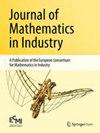用于表示 CGM 信号趋势的 ODEs 系统
IF 1.7
Q3 MATHEMATICS, INTERDISCIPLINARY APPLICATIONS
引用次数: 0
摘要
糖尿病是一种代谢性疾病,如果治疗和监测不力,可能会导致严重的并发症,甚至可能致命。在这项研究中,对天主教圣心大学阿戈斯蒂诺-杰梅里综合诊所使用 CGM(连续血糖监测)设备收集到的八名代谢控制良好的 2 型糖尿病患者的数据进行了定量分析。特别是提出了一个状态变量受一系列随机扰动影响的常微分方程系统,并将其用于从患者数据中提取更多信息推断。在这项工作中,我们使用 Matlab 和 R 程序为每位患者找到最合适的参数值(根据 Akaike 信息准则(AIC)和贝叶斯信息准则(BIC))。拟合采用粒子群优化法,以最小化 CGM 观察数据与 ODE 模型数据之间的普通最小二乘误差。为了评估哪种概率分布最适合代表根据模型参数计算出的等待时间,还进行了拟合优度测试。最后,对与血液中葡萄糖消除率变化相关的频率直方图进行了参数和非参数密度估计,并根据数据评估了其代表参数。结果表明,所选模型成功地捕捉到了几乎所有患者的大部分血糖波动。本文章由计算机程序翻译,如有差异,请以英文原文为准。
A system of ODEs for representing trends of CGM signals
Diabetes Mellitus is a metabolic disorder which may result in severe and potentially fatal complications if not well-treated and monitored. In this study, a quantitative analysis of the data collected using CGM (Continuous Glucose Monitoring) devices from eight subjects with type 2 diabetes in good metabolic control at the University Polyclinic Agostino Gemelli, Catholic University of the Sacred Heart, was carried out. In particular, a system of ordinary differential equations whose state variables are affected by a sequence of stochastic perturbations was proposed and used to extract more informative inferences from the patients’ data. For this work, Matlab and R programs were used to find the most appropriate values of the parameters (according to the Akaike Information Criterion (AIC) and the Bayesian Information Criterion (BIC)) for each patient. Fitting was carried out by Particle Swarm Optimization to minimize the ordinary least squares error between the observed CGM data and the data from the ODE model. Goodness of fit tests were made in order to assess which probability distribution was best suitable for representing the waiting times computed from the model parameters. Finally, both parametric and non-parametric density estimation of the frequency histograms associated with the variability of the glucose elimination rate from blood were conducted and their representative parameters assessed from the data. The results show that the chosen models succeed in capturing most of the glucose fluctuations for almost every patient.
求助全文
通过发布文献求助,成功后即可免费获取论文全文。
去求助
来源期刊

Journal of Mathematics in Industry
MATHEMATICS, INTERDISCIPLINARY APPLICATIONS-
CiteScore
5.00
自引率
0.00%
发文量
12
审稿时长
13 weeks
 求助内容:
求助内容: 应助结果提醒方式:
应助结果提醒方式:


